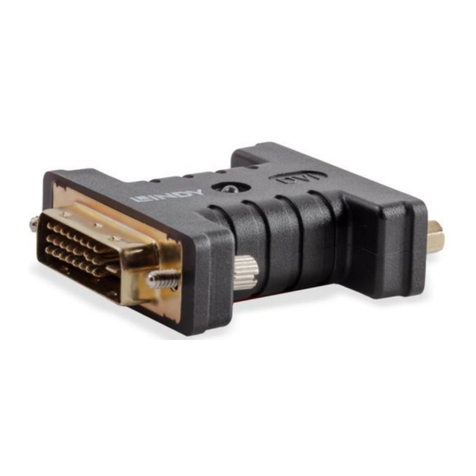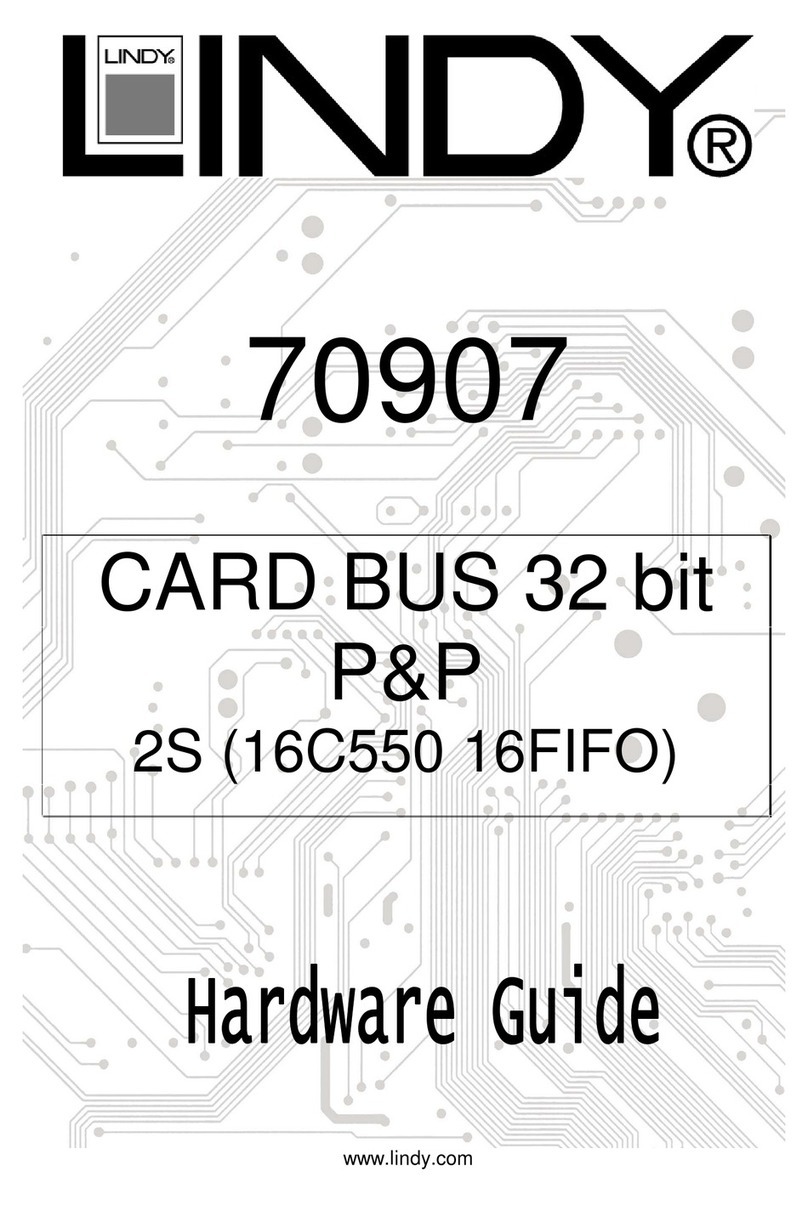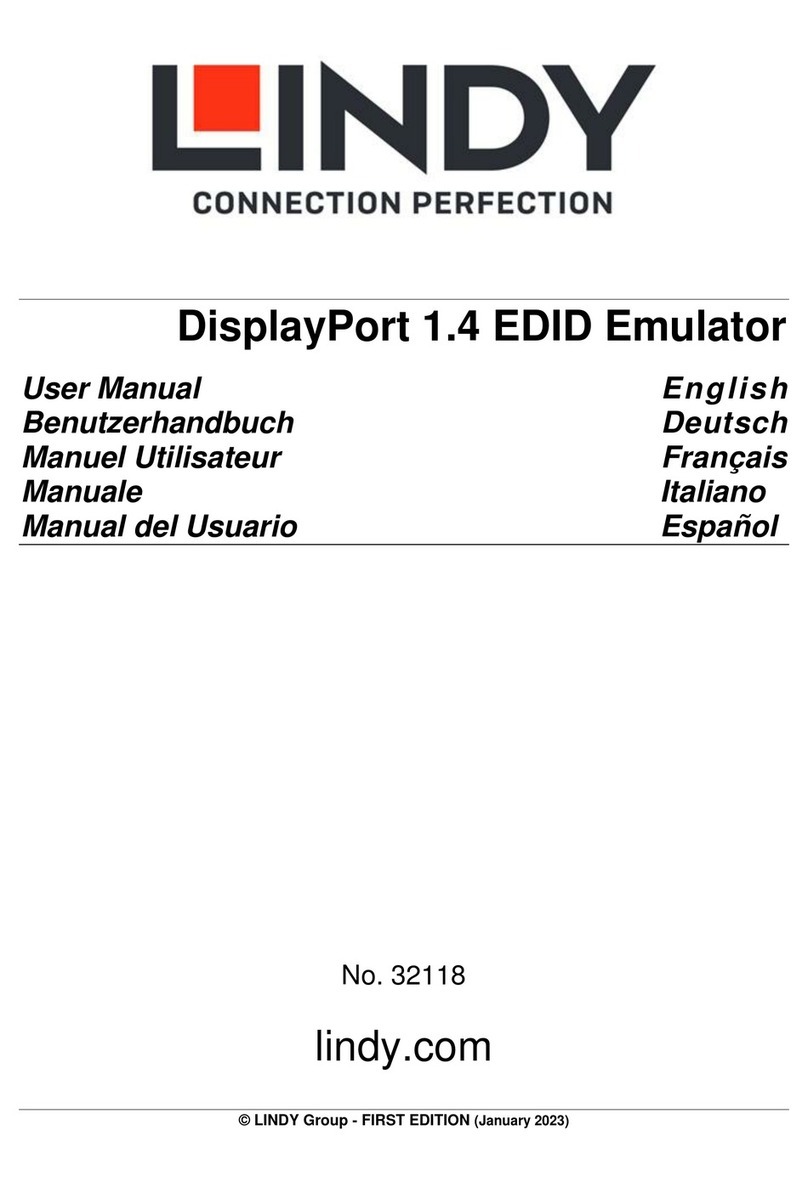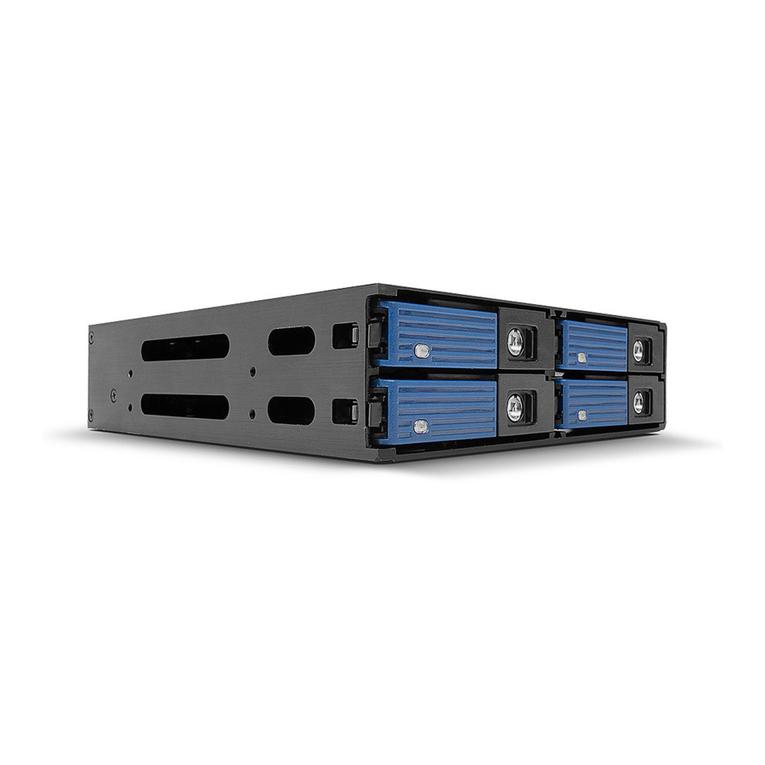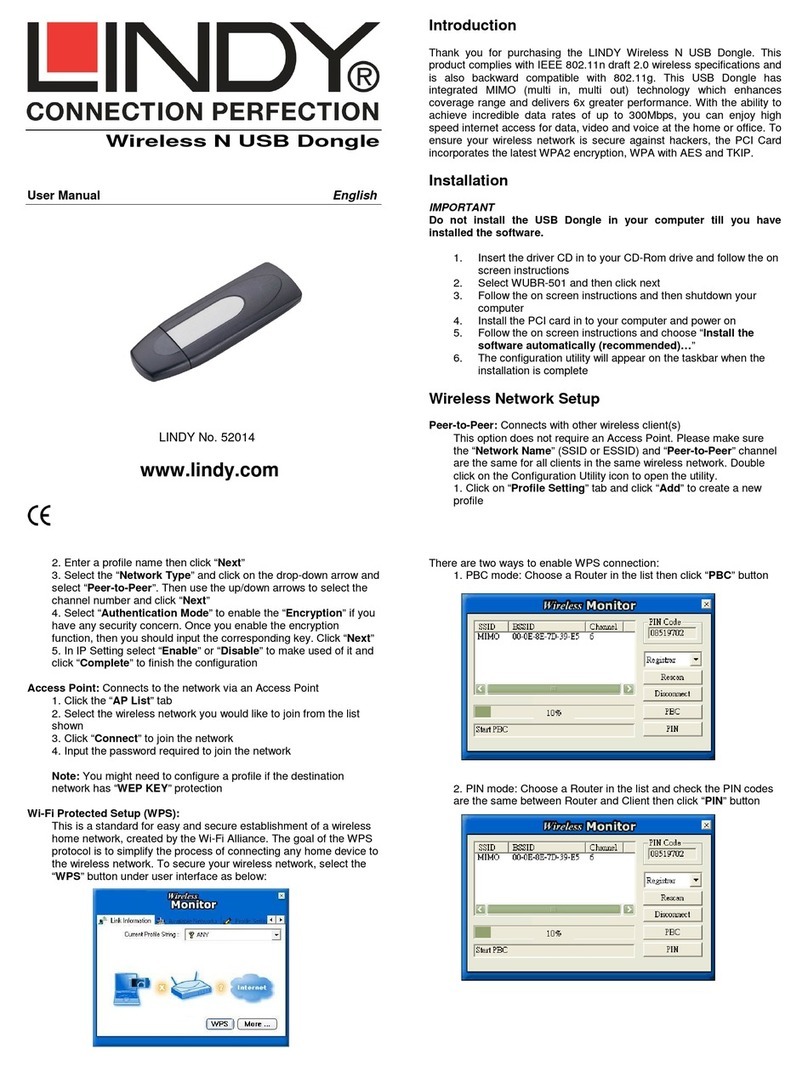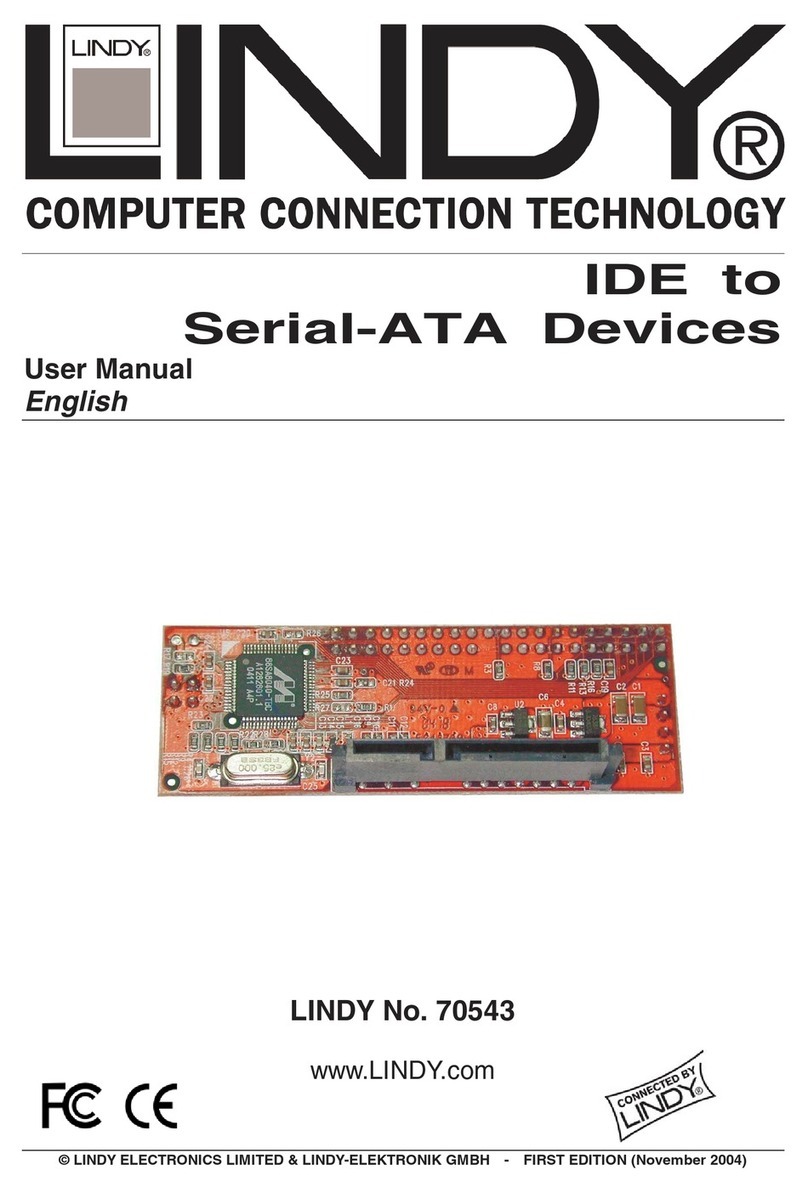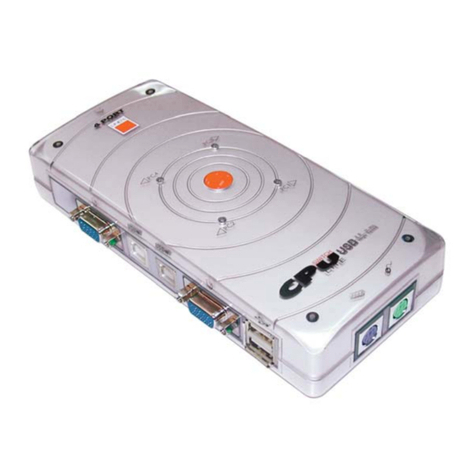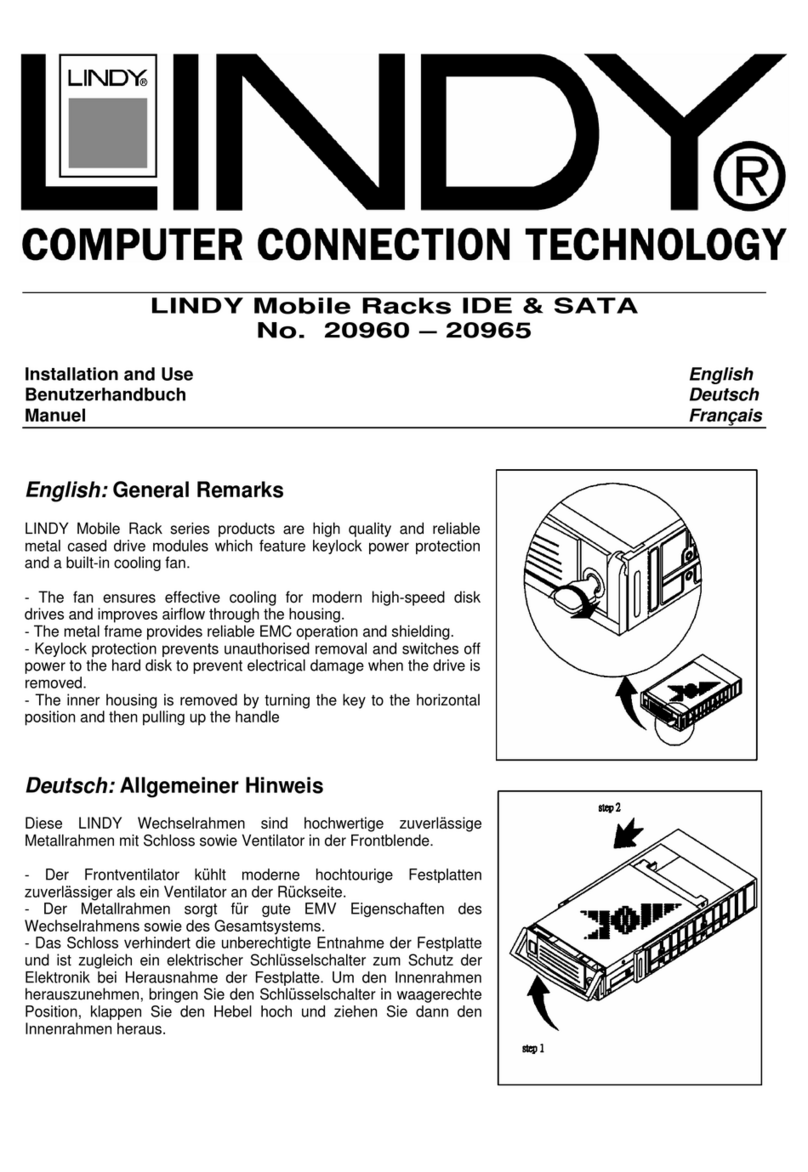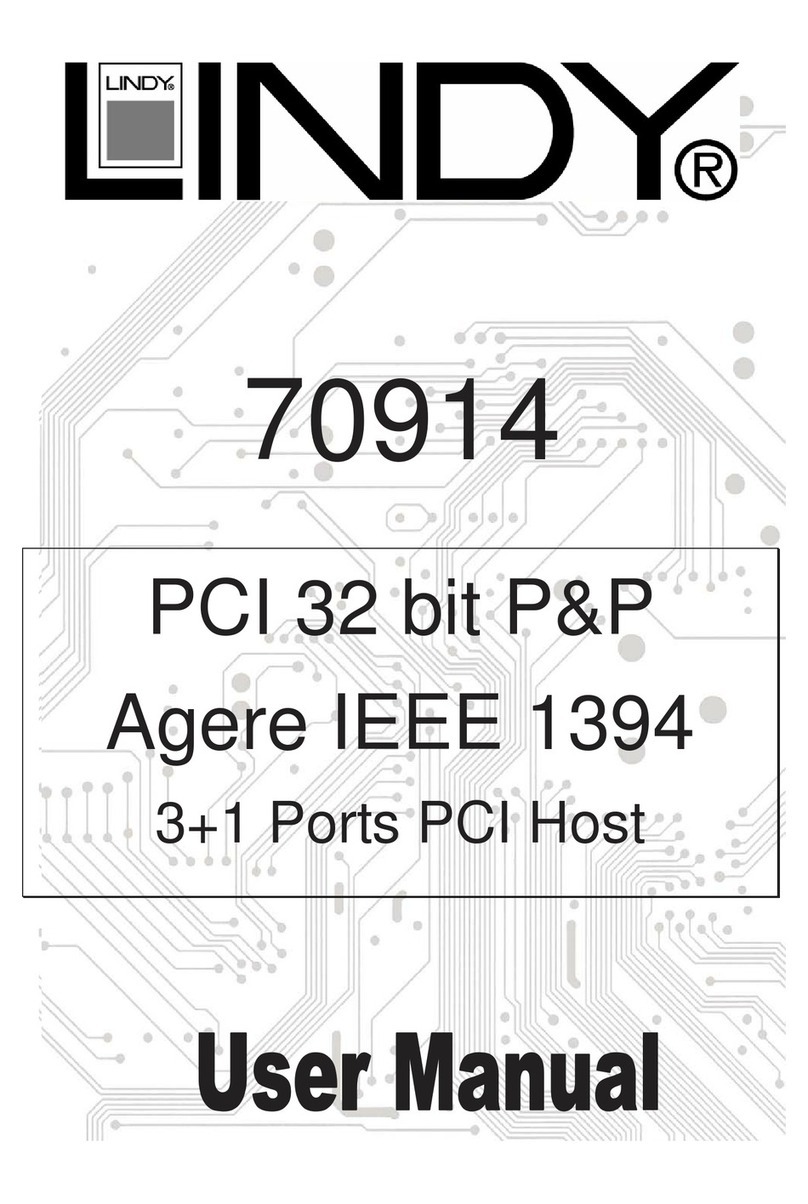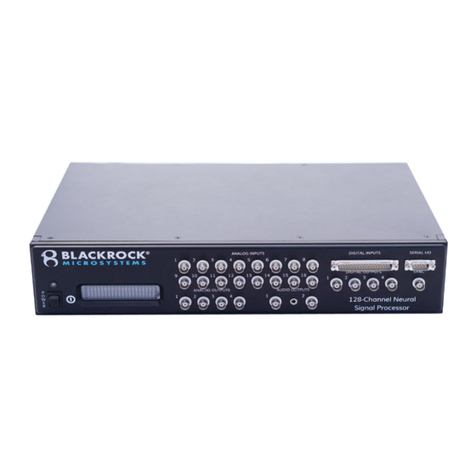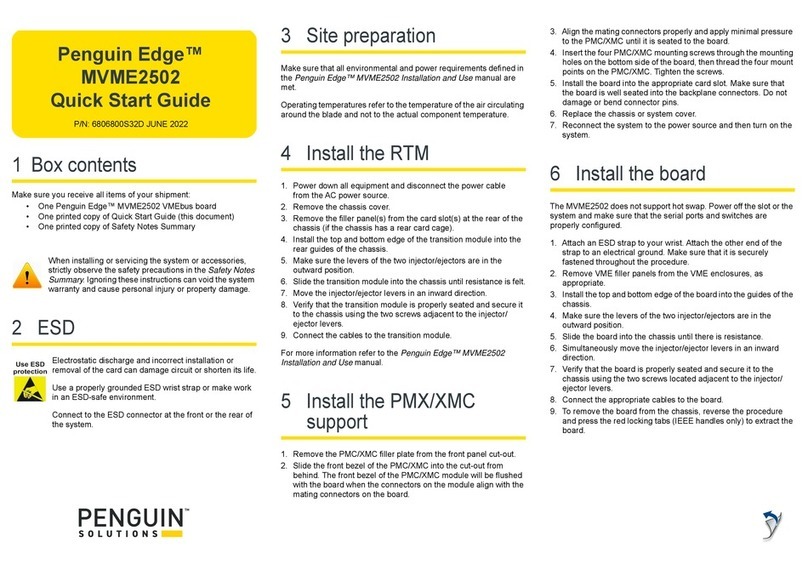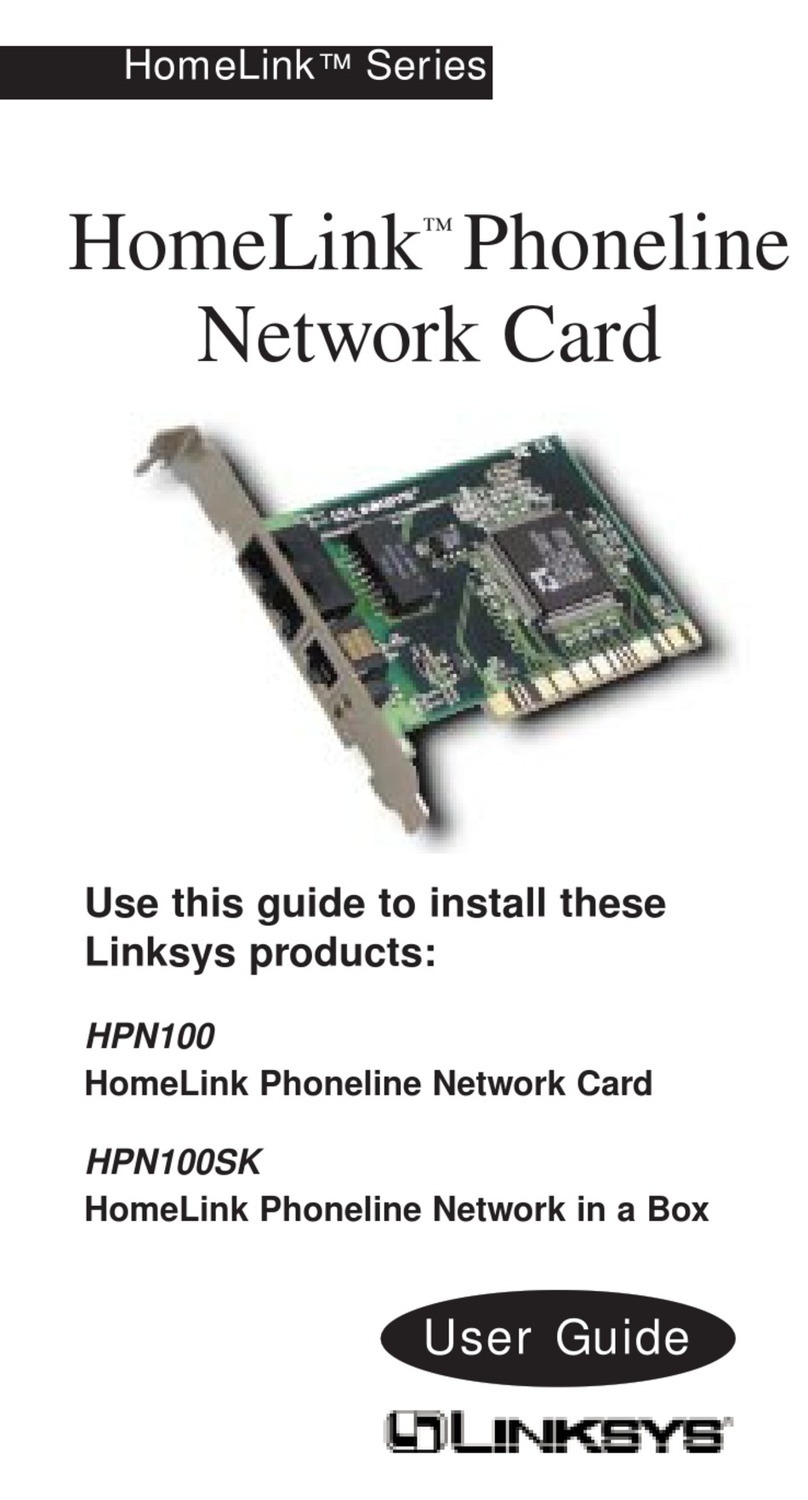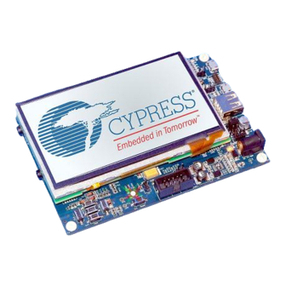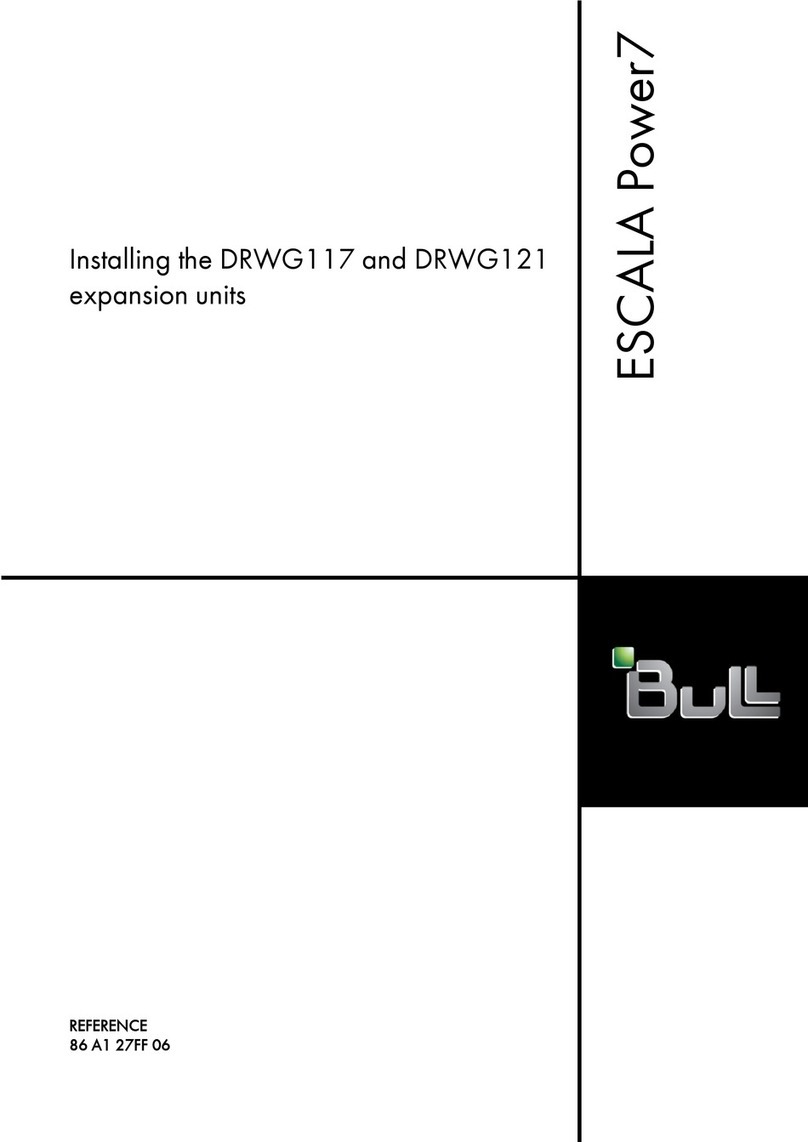Lindy 32116 User manual

© LINDY Group - THIRD EDITION
DisplayPort 1.2 EDID Emulator
User Manual English
Benutzerhandbuch Deutsch
Manuel Utilisateur Français
Manuale Italiano
No. 32116
lindy.com
Tested to comply with
FCC Standards
For Home and Office Use!


User Manual English
Introduction
Thank you for purchasing the Lindy DP 1.2 EDID Emulator This product has been designed to provide
trouble free, reliable operation. It benefits from both a LINDY 2 year warranty and free lifetime technical
support. To ensure correct use, please read this manual carefully and retain it for future reference.
The Lindy DisplayPort 1.2 EDID Emulator Adapter is designed for systems that require EDID signals to be
continuously provided without interruption and helps overcome EDID related problems which can occur
when using AV/KVM Extenders, Switches and Splitters.
Package Contents
▪DisplayPort 1.2 EDID Emulator
▪This manual
Features
▪Supports EDID Learning and EDID Emulation
▪Supports resolutions up to 3840x2160@60Hz 4:4:4 8bit and HDCP 1.3
▪Powered via DP source interface
Installation and Use
The EDID Emulator contains pre-set EDID information for many commonly used resolutions and refresh
rates, please refer to the table on the following page. To use the pre-set data skip to step 8 of the cloning
procedure.
Cloning Procedure
1. Firstly ensure the switch is in the Emulator position.
2. Connect a standard DP cable to the DP Input port of the display which you want to clone –but do
not connect it to the emulator
3. Inset the male DP connector of the Emulator into the DP Output port of your source device and
connect the DP cable to the emulator.
4. Remove the DP cable from the emulator, the LED will flash blue. Within 10 seconds, re-connect
the DP cable to the emulator.
5. When the LED is solid blue, the DP EDID learning process has been successful.
6. The Emulator can then be disconnected from the source and DP cable and installed as required,
please see the installation examples below for suggested positioning within an installation.
7. It is recommended that all equipment is power cycled, before the Emulator is used, to reinitiate
the DP handshake.
8. When installing the emulator, attach one end of a DP cable to the display/extender or switch and
the other end to the emulator. Finally connect the emulator to the source device.
Please note: If the default EDID is required, please switch to the ‘Default’ option.

User Manual English
Example for use with extender:
Example for use with a switch:
Pre-set EDID Data
Video EDID:
Resolution
Refresh
Resolution
Refresh
640 x 480p
60Hz
1680 x 1050p
60Hz
800 x 600p
60Hz
1920 x 1080p
60Hz
1024 x 768p
60Hz
1920 x 1200p
59.95Hz
1280 x 720p
60Hz
2560 x 1440p
59.95Hz
1280 x 960p
60Hz
2560 x 1600p
59.95Hz
1280 x 1024p
60Hz
3840 x 2160p
24/30/60Hz
1440 x 900p
60Hz
Please note: In addition to the default EDID resolutions, there may be some different resolutions based
on the source device and display’s capabilities
Audio EDID:
•LPCM 2-channel, 16 bit depths at 48 kHz
Troubleshooting
Windows shows a ‘Generic Non-PnP Monitor’ is connected – Please ensure that the emulator is directly
connected to the DP source by its male connector and that the Status LED is solid blue.
EDID Data is not clone –Repeat the steps above, taking care to attach the DP cable from the display to
the emulator whilst the LED flashes blue.

Benutzerhandbuch Deutsch
Einführung
Wir freuen uns, dass Ihre Wahl auf ein LINDY-Produkt gefallen ist und danken Ihnen für Ihr Vertrauen.
Sie können sich jederzeit auf unsere Produkte und einen guten Service verlassen. Dieser Lindy DP 1.2
EDID Emulator unterliegt einer 2-Jahres LINDY-Herstellergarantie und lebenslangem, kostenlosen
technischen Support. Bitte lesen Sie diese Anleitung sorgfältig und bewahren Sie sie auf.
Dieser kompakte Adapter wurde speziell für Anwendungen konzipiert, bei welchen dauerhaft eine
zuverlässige Verfügbarkeit der EDID gewährleistet werden muss. Er speichert und emuliert die EDID
eines Displays, damit Signalquellen auch bei einer Störung das Signal nicht abschalten oder verändern -
ideal für Anwendungen in Verbindung mit AV/KVM-Extendern, -Switches oder auch -Splittern.
Lieferumfang
▪DisplayPort 1.2 EDID Emulator
▪Dieses Handbuch
Eigenschaften
▪Unterstützt EDID-Learning und EDID-Emulation
▪Unterstützt Auflösungen von bis zu 3840x2160@60Hz 4:4:4 8Bit und HDCP 1.3
▪Die Stromversorgung erfolgt über den Port der DisplayPort-Quelle
Installation
Dieser EDID-Emulator enthält voreingestellte EDID-Daten für zahlreiche, gängige Auflösungen und
Bildwiederholfrequenzen –siehe Tabelle im nachfolgenden Abschnitt. Um diese Daten zu nutzen, gehen
Sie direkt zu Schritt 8 der folgenden Anweisungen.
Klonvorgang:
1. Stellen Sie sicher, dass sich der Schalter in der Emulatorposition befindet.
2. Verbinden Sie im Anschluss ein Standard-DisplayPort-Kabel mit dem gewünschten Display –
verbinden Sie das Kabel noch nicht mit dem Emulator.
3. Verbinden Sie nun den Stecker des Emulators mit dem DisplayPort-Ausgang der Quelle -
verbinden Sie dann das DisplayPort-Kabel mit dem Emulator.
4. Entfernen Sie das DisplayPort-Kabel vom Emulator –die LED sollte nun blau blinken. Verbinden
Sie innerhalb der darauf folgenden 10 Sekunden das DisplayPort-Kabel erneut mit dem
Emulator.
5. Wenn die LED blau leuchtet, wurde der EDID-Learning-Prozess erfolgreich durchgeführt.
6. Der Emulator kann nun von der Quelle entfernt werden. Das DisplayPort-Kabel kann wie
gewünscht installiert werden. Empfehlungen für die Positionierung innerhalb einer Installation
finden Sie in den folgenden Installationsbeispielen.
7. Um einen erfolgreichen Handshake zu erhalten, empfehlen wir vor der Nutzung des Emulators
alle Geräte aus- und wieder einzuschalten.

Benutzerhandbuch Deutsch
8. Während einer Installation muss immer das eine Ende des Kabels mit dem Display oder
Extender verbunden sein. Das andere Ende des Kabels muss immer mit dem Emulator
verbunden werden. Verbinden Sie erst dann den Emulator mit dem Quellgerät.
Bitte beachten: Schalten Sie den Emulator auf „Default“, falls die voreingestellten EDID-Daten benötigt
werden.
Beispiel für die Installation mit einem Extender:
Beispiel für die Installation mit einem KVM Switch:
Voreingestellte EDID-Daten
Video-EDID:
Resolution
Refresh
Resolution
Refresh
640 x 480p
60Hz
1680 x 1050p
60Hz
800 x 600p
60Hz
1920 x 1080p
60Hz
1024 x 768p
60Hz
1920 x 1200p
59.95Hz
1280 x 720p
60Hz
2560 x 1440p
59.95Hz
1280 x 960p
60Hz
2560 x 1600p
59.95Hz
1280 x 1024p
60Hz
3840 x 2160p
24/30/60Hz
1440 x 900p
60Hz
Hinweis: Zusätzlich zu den Standard-EDID-Auflösungen gibt es noch weitere Auflösungen, die durch das
Quellgerät oder die Anzeigemöglichkeiten bedingt sind.
Audio-EDID:
LPCM 2-Kanal, 16 Bit bei 48 kHz
Fehlersuche
Windows zeigt als Monitorkennung “Generic Non-PnP Monitor” – Stellen Sie sicher, dass der Adapter
direkt an einer DisplayPort-Quelle angeschlossen ist und die Status-LED blau leuchtet. Führen Sie
gegebenenfalls den EDID-Kopiervorgang erneut genau nach Beschreibung durch.
EDID Daten werden nicht kopiert –Führen Sie den EDID-Kopiervorgang erneut durch - achten Sie
darauf, das DisplayPort-Kabel anzuschließen während der Adapter noch blau blinkt.

Manuel Utilisateur Français
Introduction
Nous sommes heureux que votre choix se soit porté sur un produit LINDY et vous remercions de votre
confiance. Vous pouvez compter à tout moment sur la qualité de nos produits et de notre service. Cet
Emulateur EDID DP 1.2 LINDY est soumis à une durée de garantie LINDY de 2 ans et d’une assistance
technique gratuite à vie. Merci de lire attentivement ces instructions et de les conserver pour future
référence.
L’émulateur EDID DisplayPort 1.2 LINDY est conçu pour les systèmes qui requièrent que les signaux
EDID soient transmis sans interruption et aide à surmonter les problèmes relatifs à l’EDID qui peuvent
survenir lors de l’utilisation d’extender AV/KVM, Switchs et Splitters.
Contenu de l’emballage
▪Emulateur EDID DisplayPort 1.2
▪Ce manuel
Caractéristiques
▪Prend en charge l’apprentissage et l’émulation des signaux EDID
▪Prend en charge les résolutions jusqu’à 3840x2160@60Hz 4:4:4 8bit et HDCP 1.3
▪Alimenté par l’interface de la source DP
Installation & Utilisation
L’émulateur EDID contient une présélection d’informations EDID pour les résolutions et fréquences les
plus utilisées, merci de vous référer au tableau de la page suivante. Pour utiliser les données
présélectionnées, rendez-vous à l’étape 8 de la procédure de clonage ci-dessous.
Procédure de clonage
1. Assurez-vous que l’émulateur est en mode Emulation.
2. Connectez un câble DP standard au port d’entrée DP de l’affichage que vous voulez cloner –
mais ne le connectez pas à l’émulateur
3. Insérez le connecteur DP mâle de l’émulateur dans le port de sortie DP de votre source et
connectez le câble DP à l’émulateur.
4. Retirez le câble DP de l’émulateur, la LED va flasher en bleu. Dans un délai de 10 secondes,
reconnectez le câble DP à l’émulateur.
5. Lorsque la LED bleue reste fixe, la procédure d’apprentissage d’EDID DP est finalisée avec
succès.
6. L’émulateur peut être déconnecté de la source et du câble DP et installé comme requis.
7. Il est recommandé de redémarrer tous les équipements avant d’utiliser l’émulateur, pour
réinitialiser le handshake (appairage) DP.
8. Lors de l’installation de l’émulateur, raccordez une extrémité du câble DP à l’affichage /extender
ou switch et l’autre extrémité à l’émulateur. Pour finir, connectez l’émulateur à la source.
Note: si l’EDID par défaut est requis, commutez sur l’option ‘Default’.

Manuel Utilisateur Français
Exemple d’utilisation avec un extender:
Exemple d’utilisation avec un switch:
Présélections de données EDID
EDID Vidéo:
Résolutions
Fréqu.
Résolutions
Fréqu.
640 x 480p
60Hz
1680 x 1050p
60Hz
800 x 600p
60Hz
1920 x 1080p
60Hz
1024 x 768p
60Hz
1920 x 1200p
59.95Hz
1280 x 720p
60Hz
2560 x 1440p
59.95Hz
1280 x 960p
60Hz
2560 x 1600p
59.95Hz
1280 x 1024p
60Hz
3840 x 2160p
24/30/60Hz
1440 x 900p
60Hz
Note: outre les résolutions EDID par défaut, il peut exister différentes résolutions basées sur le
périphérique source et les capacités de l’écran
EDID Audio:
•LPCM 2 canaux, 16 bit sous 48 kHz
Dépannage
Windows indique qu’un moniteur ‘Generic Non-PnP’ est connecté – Merci de vous assurer que
l’émulateur est directement connecté à la source DP avec son connecteur mâle et que la LED de statut
est bleu fixe.
Les données EDID ne sont pas clonées –Répétez les étapes de la procédure de clonage, en vous
assurant de raccorder le câble DP de l’affichage à l’émulateur pendant que la LED clignote en bleu.

Manuale Italiano
Introduzione
Vi ringraziamo per aver acquistato l’emulatore EDID DP 1.2 Lindy. Questo prodotto è stato progettato
per garantirvi la massima affidabilità e semplicità di utilizzo ed è coperto da 2 anni di garanzia LINDY
oltre che da un servizio di supporto tecnico a vita. Per assicurarvi di farne un uso corretto vi invitiamo a
leggere attentamente questo manuale e a conservarlo per future consultazioni.
L’Emulatore EDID DisplayPort 1.2 Lindy è pensato per sistemi che richiedono segnali EDID
costantemente presenti e aiuta a prevenire tutti i problemi ad essi connessi durante l’utilizzo di
apparecchiature A/V come Extender, Switch e Splitter
Contenuto della confezione
▪Emulatore EDID DisplayPort 1.2
▪Questo manuale
Caratteristiche
▪Supporto apprendimento ed emulazione EDID
▪Supporto risoluzioni fino a 3840x2160@60Hz 4:4:4 8 bit e HDCP 1.3
▪Alimentato dalla sorgente DP
Installazione & utilizzo
Questo emulatore contiene un set di informazioni EDID standard precaricate per le risoluzioni e
frequenze più utilizzate (fate riferimento alla tabella riportata nella prossima pagina). Per utilizzare questi
valori preimpostati andate direttamente al passo 8 della procedura di clonazione.
Procedura di clonazione dati EDID
1. Assicuratevi per prima cosa che lo switch sul dispositivo sia in posizione “Emulator”
2. Collegate un cavo standard DP alla corrispondente porta dello schermo da cui volete
copiare i dati ma NON collegatelo ancora all’emulatore
3. Inserite il connettore maschio dell’emulatore nella porta DP della vostra sorgente e poi
collegate il cavo proveniente dallo schermo all’emulatore
4. Rimuovete il cavo dall’emulatore e il LED lampeggerà in blu. Entro 10 secondi ricollegate
il cavo DP all’emulatore
5. Quando il LED rimarrà accesso fisso in blu la procedura di copia sarà conclusa con
successo
6. L’emulatore potrà ora essere disconnesso dalla sorgente e installato come desiderate
7. Raccomandiamo di riavviare tutti i dispositivi coinvolti nell’installazione prima di utilizzare
l’emulatore DP per permettere di rinnovare tutte le sessioni di trasmissione.

Manuale Italiano
8. Quando installate l’emulatore collegate un lato di un cavo standard DP allo schermo,
extender o switch e l’altro lato all’emulatore. Alla fine collegate l’emulatore alla vostra
sorgente.
Nota Bene: se necessitate di utilizzare la tabella standard EDID impostate lo switch
sull’emulatore nella posizione “Default”
Esempio di utilizzo con un Extender:
Esempio di utilizzo con uno switch:
Informazioni EDID preimpostate
EDID Video:
Risoluzione
Freq.
Risoluzione
Freq.
640 x 480p
60Hz
1680 x 1050p
60Hz
800 x 600p
60Hz
1920 x 1080p
60Hz
1024 x 768p
60Hz
1920 x 1200p
59.95Hz
1280 x 720p
60Hz
2560 x 1440p
59.95Hz
1280 x 960p
60Hz
2560 x 1600p
59.95Hz
1280 x 1024p
60Hz
3840 x 2160p
24/30/60Hz
1440 x 900p
60Hz
Nota Bene: in aggiunta alle risoluzioni EDID standard, ci possono essere alcune risoluzioni differenti in
base alle caratteristiche delle sorgenti e degli schermi utilizzati
Audio EDID:
•LPCM a 2 canali, 16 bit a 48 kHz
Risoluzione dei problemi
- Windows indica che un “Monitor Generico non-PnP” è collegato.
Assicuratevi che l’emulatore sia connesso direttamente alla sorgente con il connettore maschio e che il
LED sia acceso fisso in blu.
- I dati EDID non sono stati clonati
Ripetete i passi descritti sopra facendo attenzione a ricollegare il cavo DP all’emulatore mentre il LED
lampeggia in blu.

CE/FCC Statement
CE Certification
This equipment complies with the requirements relating to Electromagnetic Compatibility Standards.
It has been manufactured under the scope of RoHS compliance.
CE Konformitätserklärung
Dieses Produkt entspricht den einschlägigen EMV Richtlinien der EU für IT-Equipment und darf nur
zusammen mit abgeschirmten Kabeln verwendet werden.
Diese Geräte wurden unter Berücksichtigung der RoHS Vorgaben hergestellt.
Die formelle Konformitätserklärung können wir Ihnen auf Anforderung zur Verfügung stellen
FCC Certification
This equipment has been tested and found to comply with the limits for a Class B digital device, pursuant
to part 15 of the FCC Rules. These limits are designed to provide reasonable protection against harmful
interference in a residential installation.
You are cautioned that changes or modification not expressly approved by the party responsible for
compliance could void your authority to operate the equipment.
This device complies with part 15 of the FCC Rules.
Operation is subject to the following two conditions:
1. This device may not cause harmful interference, and
2. This device must accept any interference received, including interference that may cause undesired
operation.
LINDY Herstellergarantie –Hinweis für Kunden in Deutschland
LINDY gewährt für dieses Produkt über die gesetzliche Regelung in Deutschland hinaus eine zweijährige Hersteller-
garantie ab Kaufdatum. Die detaillierten Bedingungen dieser Garantie finden Sie auf der LINDY Website aufgelistet
bei den AGBs.
Hersteller / Manufacturer (EU):.
LINDY-Elektronik GmbH LINDY Electronics Ltd
Markircher Str. 20 Sadler Forster Way
68229 Mannheim Stockton-on-Tees, TS17 9JY
GERMANY United Kingdom
Email: info@lindy.com , T: +49 (0)621 470050 postmaster@lindy.co.uk , T: +44 (0)1642 754000

Recycling Information
WEEE (Waste of Electrical and Electronic Equipment),
Recycling of Electronic Products
Europe, United Kingdom
In 2006 the European Union introduced regulations (WEEE) for the collection and recycling of all waste electrical
and electronic equipment. It is no longer allowable to simplythrow away electrical and electronic equipment. Instead,
these products must enter the recycling process.
Each individual EU member state has implemented the WEEE regulations into national law in slightly different ways.
Please follow your national law when you want to dispose of any electrical or electronic products. More details can
be obtained from your national WEEE recycling agency.
Germany / Deutschland Rücknahme Elektroschrott und Batterie-Entsorgung
Die Europäische Union hat mit der WEEE Direktive Regelungen für die Verschrottung und das Recycling von Elektro-
und Elektronikprodukten geschaffen. Diese wurden im Elektro- und Elektronikgerätegesetz –ElektroG in deutsches
Recht umgesetzt. Das Entsorgen von Elektro- und Elektronikgeräten über die Hausmülltonne ist verboten! Diese
Geräte müssen den Sammel- und Rückgabesystemen zugeführt werden! Dort werden sie kostenlos entgegen
genommen. Die Kosten für den weiteren Recyclingprozess übernehmen die Gerätehersteller.
LINDY bietet deutschen Endverbrauchern ein kostenloses Rücknahmesystem an, beachten Sie bitte, dass Batterien
und Akkus den Produkten vor der Rückgabe an das Rücknahmesystem entnommen werden müssen und über die
Sammel- und Rückgabesysteme für Batterien separat entsorgt werden müssen. Ausführliche Informationen zu
diesen Themen finden Sie stets aktuell auf der LINDY Webseite im Fußbereich.
France
En 2006, l'union Européenne a introduit la nouvelle réglementation (DEEE) pour le recyclage de tout équipement
électrique et électronique.
Chaque Etat membre de l’ Union Européenne a mis en application la nouvelle réglementation DEEE de manières
légèrement différentes. Veuillez suivre le décret d’application correspondant à l’élimination des déchets électriques
ou électroniques de votre pays.
Italy
Nel 2006 l’unione europea ha introdotto regolamentazioni (WEEE) per la raccolta e il riciclo di apparecchi elettrici ed
elettronici. Non è più consentito semplicemente gettare queste apparecchiature, devono essere riciclate. Ogni stato
membro dell’ EU ha tramutato le direttive WEEE in leggi statali in varie misure. Fare riferimento alle leggi del proprio
Stato quando si dispone di un apparecchio elettrico o elettronico.
Per ulteriori dettagli fare riferimento alla direttiva WEEE sul riciclaggio del proprio Stato.
LINDY No 32116
3rd Edition, April 2019
lindy.com
Table of contents
Languages:
Other Lindy Computer Hardware manuals
Popular Computer Hardware manuals by other brands
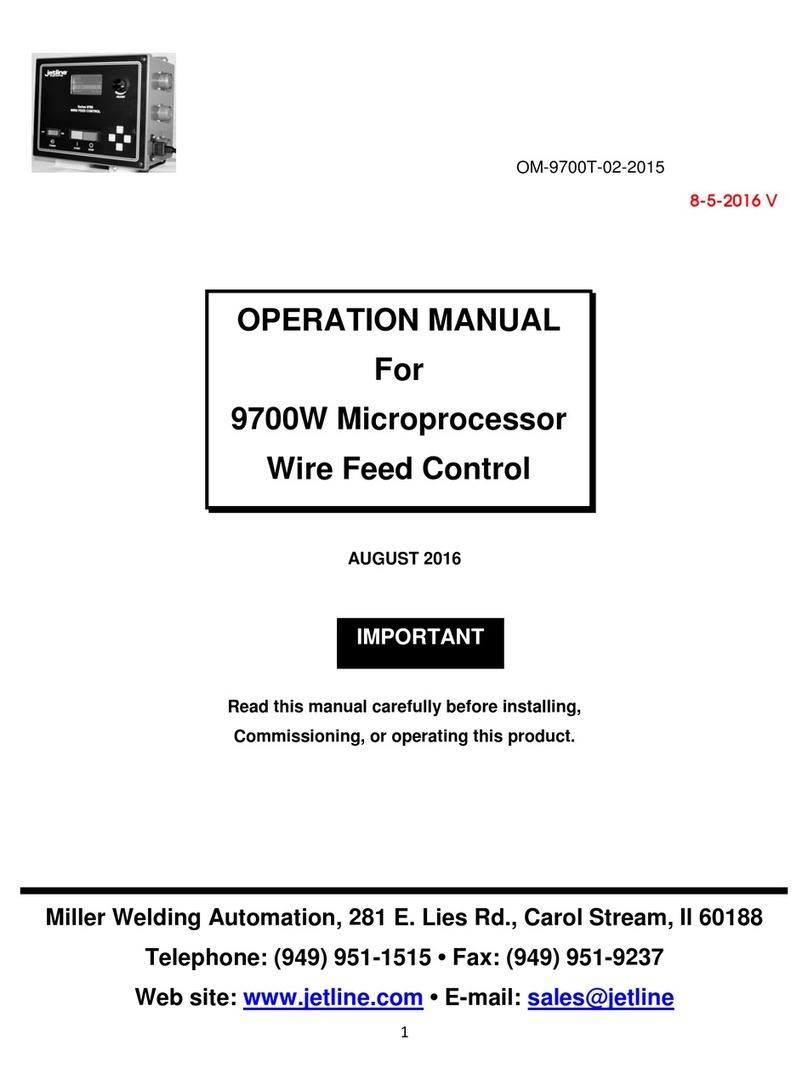
Miller
Miller 9700W Operation manual
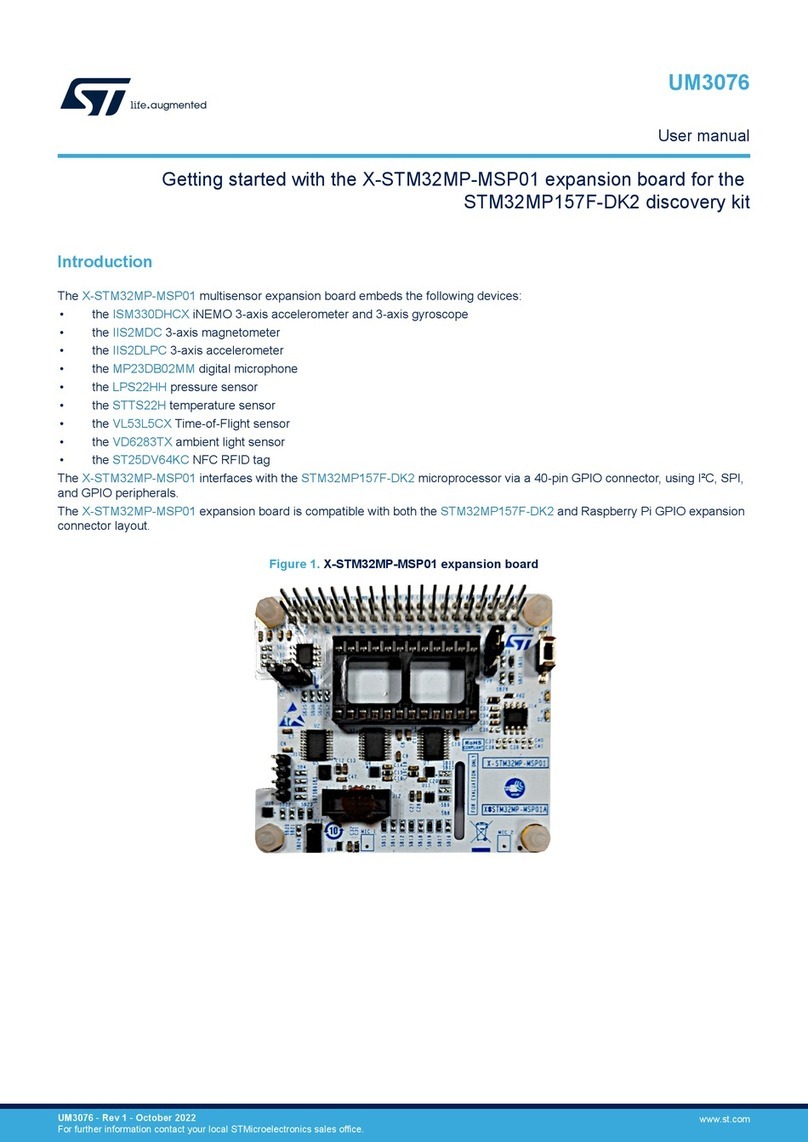
ST
ST X-STM32MP-MSP01 Getting started
Freescale Semiconductor
Freescale Semiconductor FRDM-K64F quick start guide
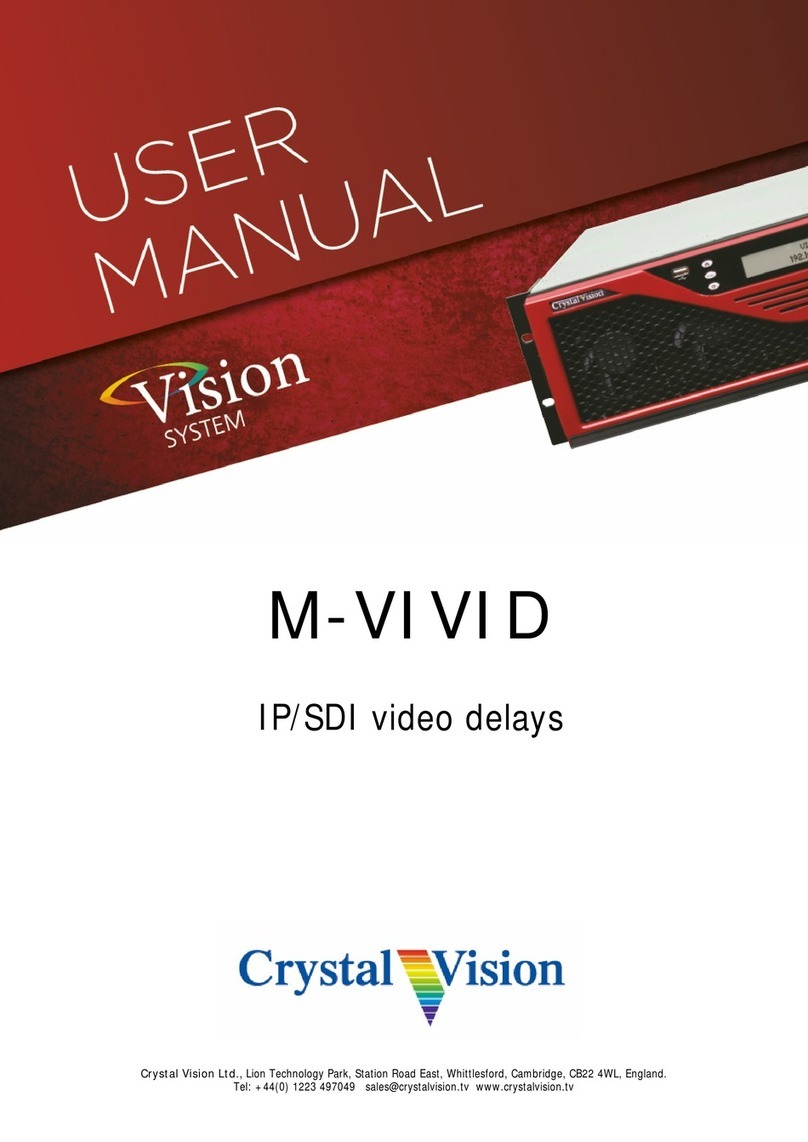
Crystal Vision
Crystal Vision Vision M-VIVID user manual

Intel
Intel E2180 - Pentium Dual-Core 2.00GHz 800MHz 1MB Socket 775... Design guidelines
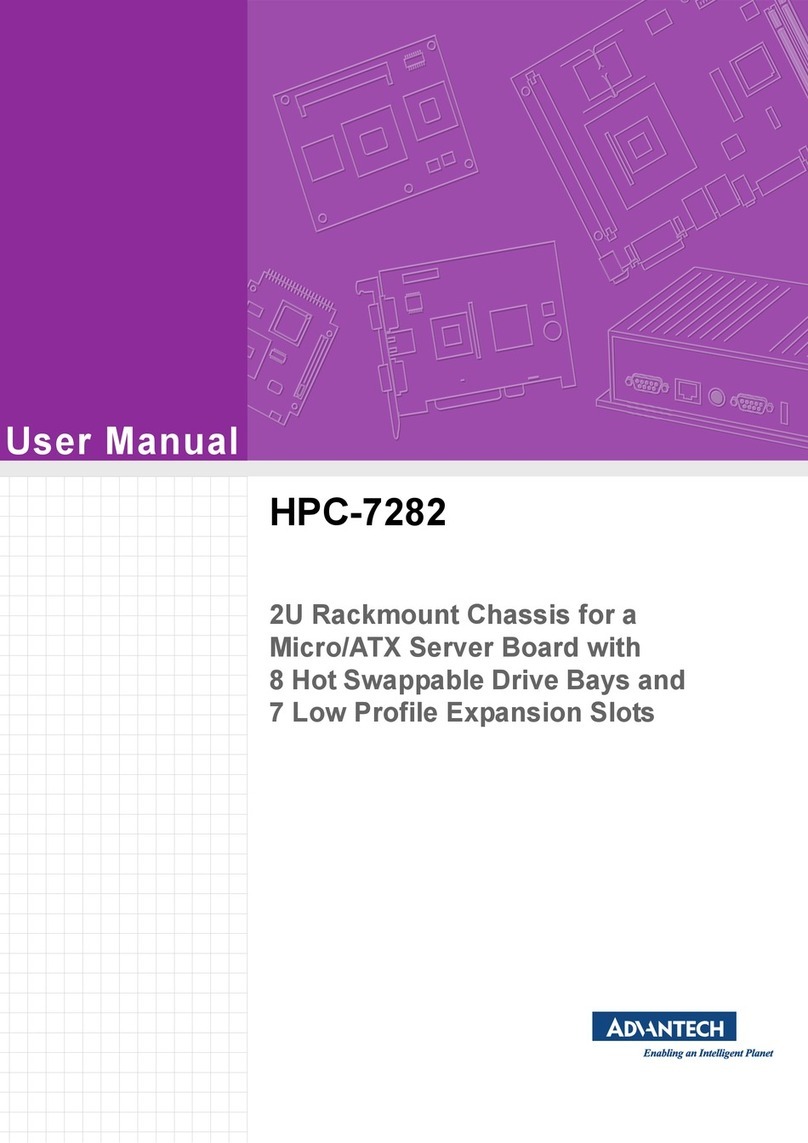
Advantech
Advantech HPC-7282 user manual
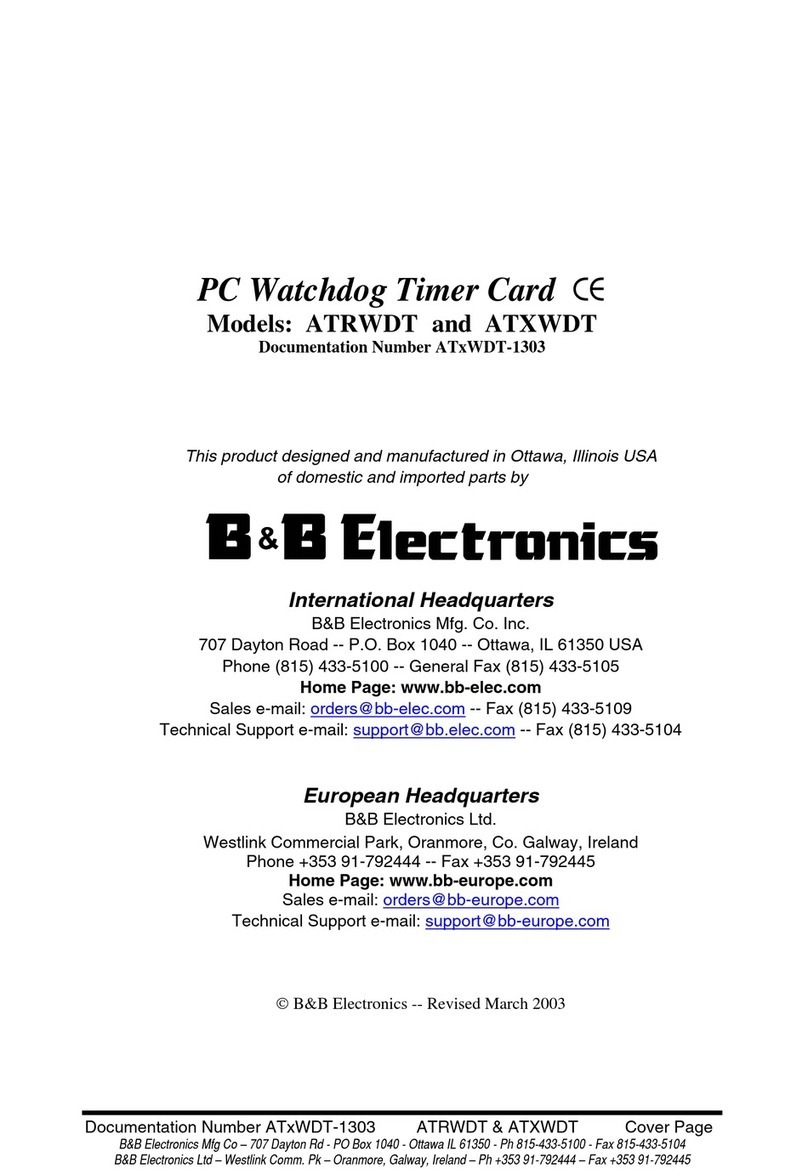
B&B Electronics
B&B Electronics PC Watchdog Timer Card ATRWDT user manual
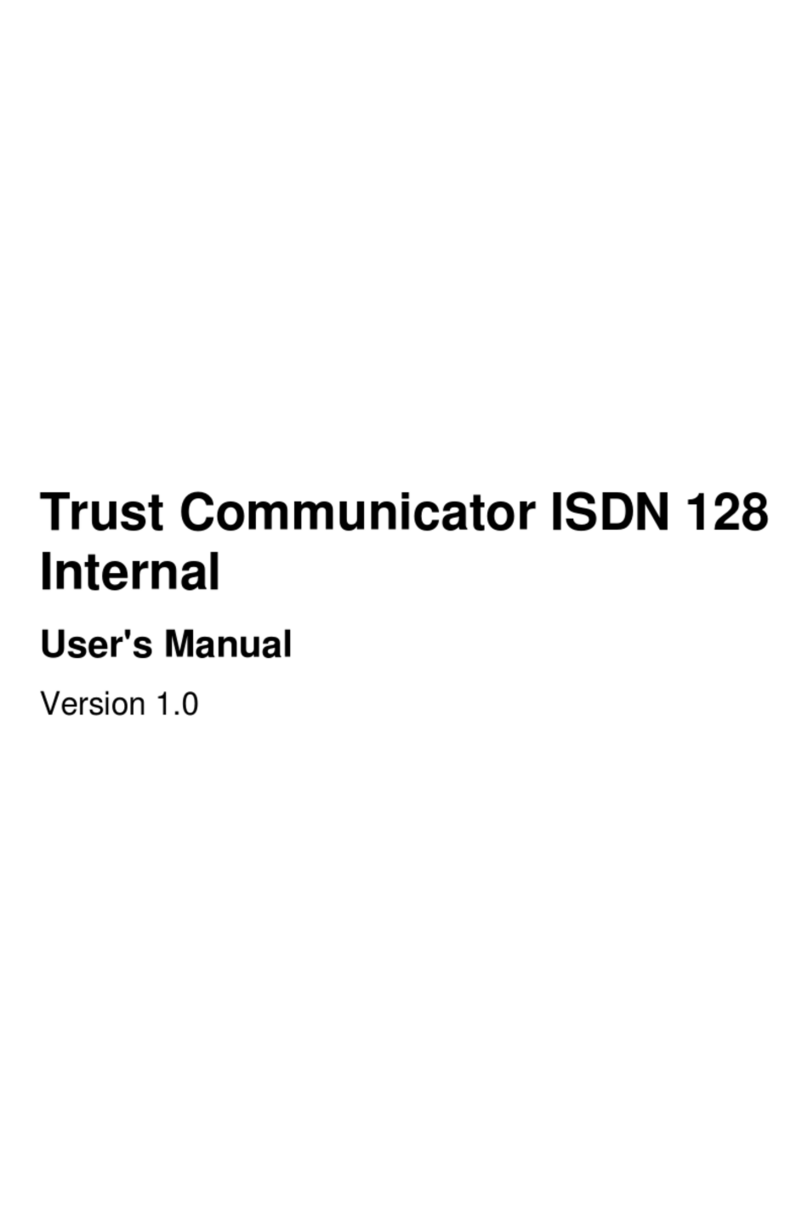
Trust
Trust ISDN 128 user manual

Nvidia
Nvidia Quadro installation guide
National Semiconductor
National Semiconductor DP8400 Application note
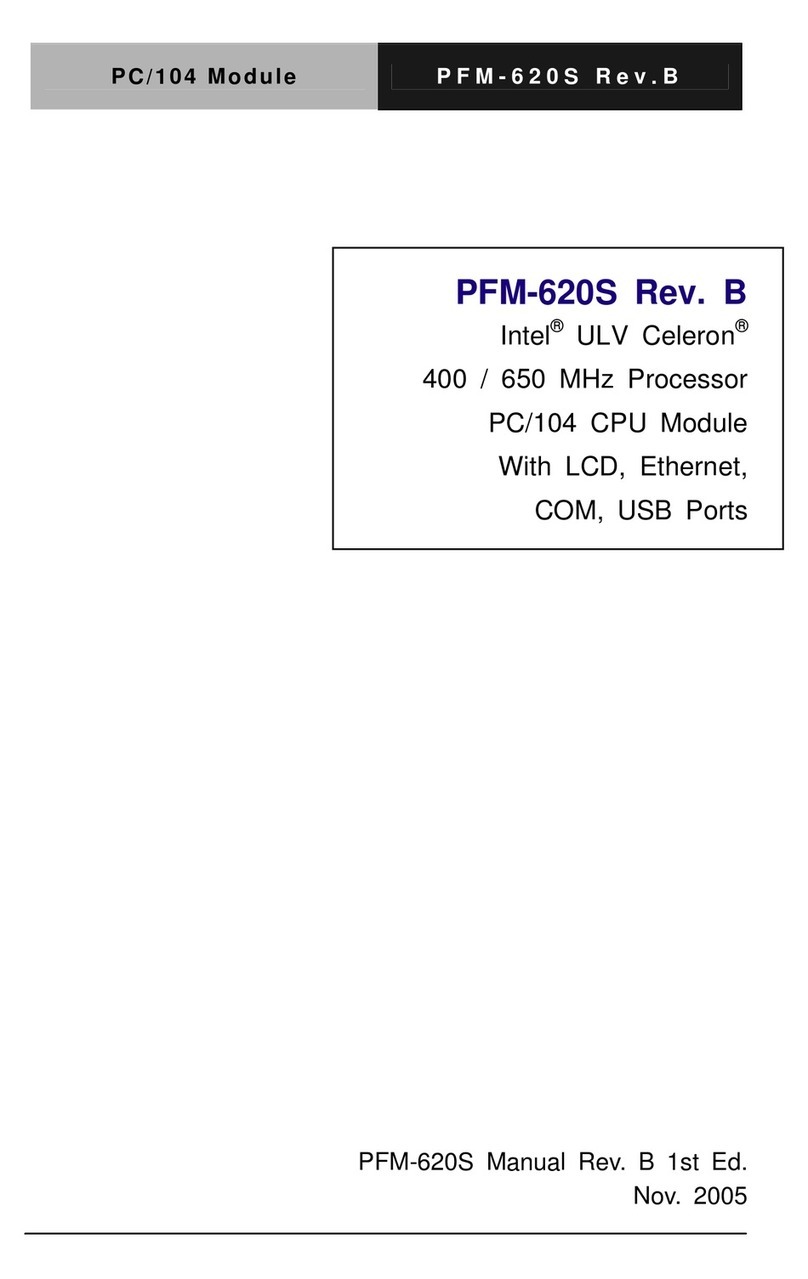
Aaeon
Aaeon PFM-620S manual
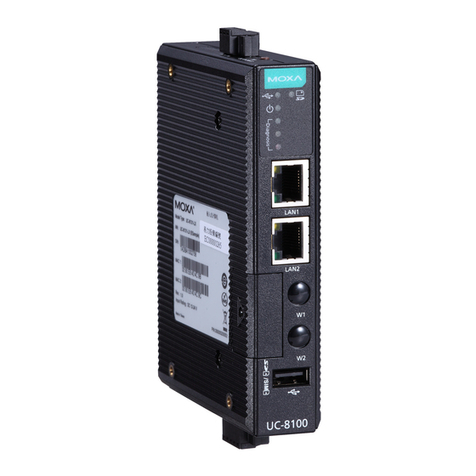
Moxa Technologies
Moxa Technologies UC-8100 Series Quick installation guide

